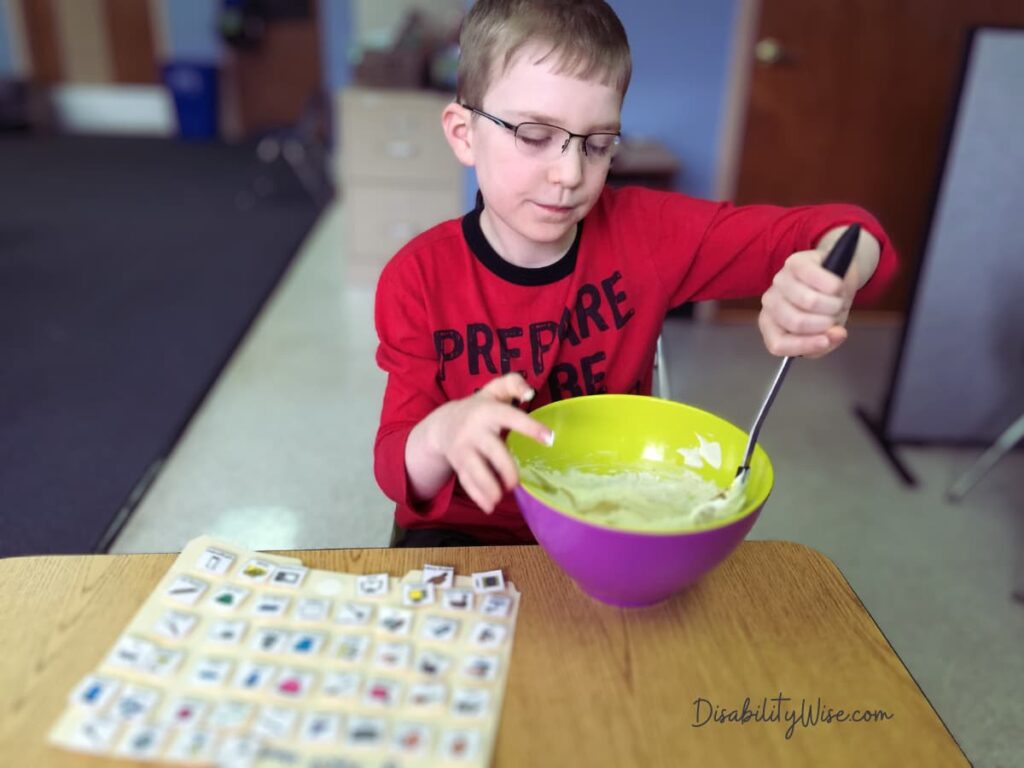When our son started preschool, my husband and I knew we would need to look for a different special education program in another school district before he entered grade school. Our district at the time just wasn’t a good fit for our family.

So, before Ian entered Kindergarten, I got busy planning our family’s next step…and did I feel the pressure!
After all, the school years aren’t just a thirteen-year commitment. For our children, it’s potentially seventeen years if they defer their diploma, enter a transitional program, and stay until age 22.
It felt like Ian’s future hinged on this decision, so I was determined to leave no stone unturned. Private and public schools, urban and rural districts — you name it, I was going to research them all.

But, instead of drowning in a sea of options, I narrowed our choices by focusing on our goals for Ian and what we wanted from a program. Knowing ahead of time what we were striving for made it so much easier to spot the programs that were going to work and the ones that weren’t.
In this post, I’ll share the five steps that led us to our current district and what I would change about our decision (if anything) ten years out.
I hope these tips help you if you’re considering a new program for your child or simply want to explore your options.
Tip #1: Understand Your Child’s Needs

A great place to start is by asking yourself: What does my child need to succeed during their school day?
Knowing and listing your child’s needs at the beginning of your search will help you keep what’s most important front and center as you go through your decision-making process.
Does your child have an IEP or 504? Make sure to use it! They’re a great tool to refer to while brainstorming ideas. Here are a few questions to help jump-start your list.
- Would my child do better in a large or small classroom setting?
- What type of instruction would benefit my child: specially designed, general education with supports, inclusive, or a hybrid approach?
- What supports, therapies, modifications, and resources does my child need to thrive throughout their school day?
Tip #2: List Your Program Expectations
Now that you have a list of your child’s needs, it’s time to create another list. Can you tell I love list-making? (Haha) You will be grateful for them, I promise!

For this list, start by thinking about what your expectations are for the program itself. Understanding your expectations will help give you better direction and a clearer picture of what you hope to achieve for your child. Not sure what your expectations are? I’ve listed some questions to consider when thinking through ideas:
- How many students with special needs are enrolled in the school or district? This will give you a good idea of the level of experience they have with students with disabilities. True story, I spoke to one rural district that had only served two students with disabilities over three years — numbers matter!
- What are the student-to-teacher and student-to-paraprofessional ratios?
- What is the average number of students in a special education classroom?
- What types of classroom settings are available, such as inclusive, self-contained, resource room, or combination/hybrid?
- Inquire about the availability of a transition program post-high school. If so, what does the program entail?
Having lists of my son’s needs and my program expectations helped me stay organized and focused during my phone interviews with schools. I hope you find them as useful as I did.
Tip #3: Visiting and Observing Programs
While speaking with each school over the phone can be super informative, nothing replaces first-hand observations. Visiting special education programs in person will allow you to see how they work in the day-to-day. Also, it never seemed to matter how many questions I asked during a phone interview; my visits always led to more.
When visiting programs, it’s best to go during regular school hours so you can observe the students and teachers in action. Make notes as you walk through the learning environment, and pay attention to student involvement, teacher interaction, and classroom organization that might give insights into students’ daily activities.
Before scheduling your visit, peek at your state’s report card and see how the district you’re interested in holds up to others — a super handy tool.
Tip #4: Reach Out to Other Parents

Parents of children with special needs understand the value of connecting with other parents. When looking for direction, my community or “tribe” is one of the first places I turn to. Nothing can replace first-hand experience and wisdom.
Don’t have a tribe? Parent groups on social media, like Facebook, are a great way to connect with parents in your area. These groups allow you to get parents’ personal experiences with nearby school districts.
Not on social media? Take the opportunity to connect with parents at your child’s sporting events, playgroups, or therapy sessions. Poke around and ask if they are happy with the district or program their child is in.
Tip #5: Research the Developmental Disabilities (DD) Agency
If your child is eligible for developmental disabilities services and those services are county- or state-based, deciding on which county or state you live in is just as important as picking your child’s program or the school district.
Think of the Developmental Disabilities (DD) Agency as a bookend that frames your child’s journey. On one end, the DD Agency offers early intervention services, and on the other, adult support and services, with the school years in between.

Do you see why the county or state you live in matters? It could potentially influence your child’s entire lifespan. So, be sure the county or state you choose to live in can support your child’s needs. Do your research!
Final Thoughts: Ten Years and Counting

It’s hard to believe that it’s been over a decade since we took a chance on a new school district and special education program for our son. From Kindergarten to now, a senior next year, it’s crazy to believe how fast time has gone!
We’ve definitely experienced some ups and downs and even second-guessed our choice at times, but through it all, Ian has managed to thrive.
One thing I’ve learned in the past ten years is that no matter how great or poor a fit a program or school district may seem, being active and engaged throughout your child’s school years is the ultimate key to their success.
So don’t be afraid to speak up and advocate for your child’s needs. It can make all the difference to their journey, no matter where you decide to land.
I’d love to hear how you chose your child’s program and what you love about it.
SHARE ON:



Very easy to read and very helpful.
Thank you so much! Glad you found it helpful 🙂
Interesting read!
Glad you liked it!